Rugby Colour Palette Project
Rugby Colour Palette Project
Following the hugely successful Royal Leamington Spa Colour Palette and Warwick Colour Palette, developed by Stacey Barnfield in collaboration with Warwick District Council, the Heart of England CRP applied to Avanti West Coast’s Project Fund to develop a community-inspired Rugby Colour Palette at Rugby Railway Station. Alongside the public consultation, the CRP commissioned Ruby Road and Jo Chalkblack to develop and deliver school and community workshops as part of the project.
We also developed an activity book for children to access so that more young people could get involved in the project that can be downloaded below.
Rugby Color Palette activity book:
After attending events, an online social media campaign and working with 5 schools and community art group, we had over 200 unique suggestions for inclusion in the colour palettes. Working with our project partners, Stacey has created three colour palettes with the themes:
History and Heritage, Creativity and Culture, and Industry and Innovation.
The colours chosen are a mix of direct references to suggestions from the public and more cryptic choices designed to encourage thought and provoke conversation around the palette.
If you want to know the inspiration behind each colour, here’s a short guide:
History and Heritage
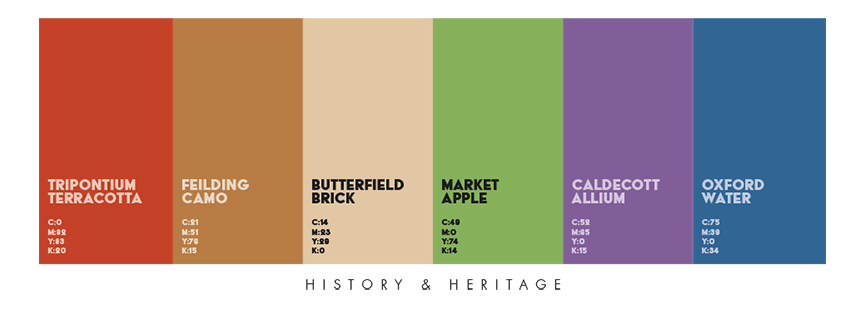
History and Heritage
Tripontium Terracotta Between 1961 and 2004 vast numbers of fragments and some complete examples of fired clay tiles were recovered during the excavations from the Roman Site of Tripontium near Rugby.
Due to the number used in the settlement, there is a high likeliness that all tiles in Tripontium were made locally. You can read more about them here."
Feilding Camo Lady Dorothie Feilding was the first woman to be awarded the Military Medal for bravery in the field during World War One in 1916 as well as being awarded the Croix de Guerre by the French and the Order of the Leopold by the Belgians. She trained at the Hospital of St Cross, Rugby and grew up on the Newnham Paddox estate near Rugby.
Butterfield Brick William Butterfield (1814 - 1900) was a renowned British architect who was prominent in the Gothic Revival in England. Nikolaus Pevsner, the art and architecture critic famous for his guide to British Architecture, once described Rugby as ‘Butterfieldtown’ - on account of the number of William Butterfield buildings in the town, including Rugby School and elements of St Andrews Church.
Market Apple Rugby was established as a Market Town in 1255 and still has weekly markets where you can find an array locally produced goods, fresh fruit, vegetables, artisan products, and clothing.
Caldecott Allium Caldecott Park, located in the town centre, is 10 acres of formal and informal sports facilities, lawn areas and award winning floral displays, including the beautiful alliums represented in the colour palette. With a bandstand, café and play area, the park is well loved by local residents and visitors alike.
Oxford Water The Oxford Canal runs round the Northern and Eastern edges of Rugby and has a popular canal walk.
Creativity and Culture
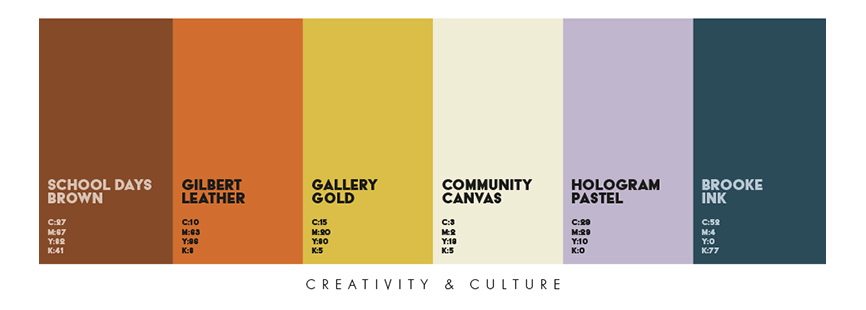
Creativity and Culture
School Days Brown Tom Brown's School Days by Thomas Hughes was published in 1857. The story is set in the 1830s at Rugby School, an English public school founded by a Tudor merchant and benefactor Lawrence Sheriff, who was notable for being grocer to Queen Elizabeth I. Hughes attended the school from 1834 to 1842 and the much of the novel is based on his experience.
Gilbert Leather The original makers of the rugby ball and founded at the start of the 19th century by William Gilbert - one of a renowned family of Cordwainers (shoemakers) in Rugby. William Gilbert had a boot and shoemakers shop next to Rugby school in the high street and started making balls for the school out of hand stitched, four panel, leather casings and real pigs bladders
Gallery Gold To reflect the beautiful golden hue of the Rugby Art Gallery and Museum building.
Community Canvas Rugby has a large and diverse creative community. We wanted to be able to reflect all the local artists and makers within the community in the colour palette.
Hologram Pastel Holography was discovered in Rugby by Hungarian-British electrical engineer and physicist Dennis Gabor whilst he was working at BTH, for which he was awarded the Nobel Prize for Physics in 1971.
Brooke Ink Rupert Chawner Brooke was an English poet known for his idealistic war sonnets written during World War One. He was educated at Rugby School and served in the Royal Navy.
Industry and Innovation
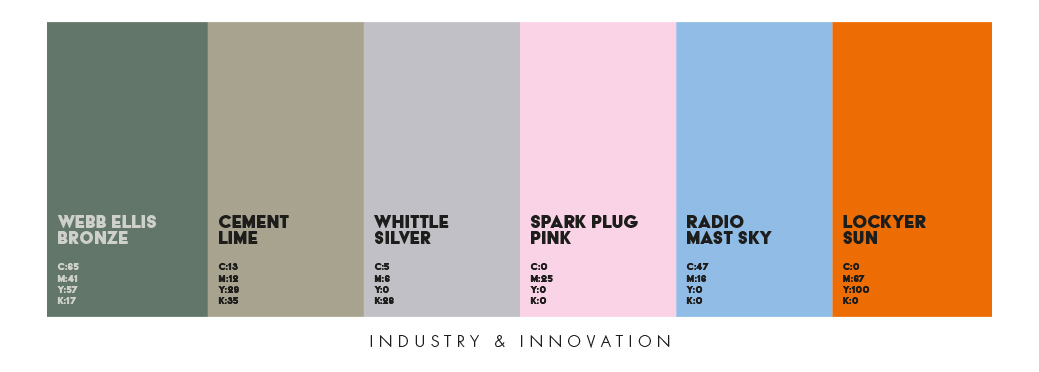
Industry and Innovation
Webb Ellis Bronze According to legend, the sport of rugby was born in 1823 when Rugby schoolboy William Webb Ellis, whilst playing football took the ball in his arms and ran with it. In 1997 a bronze-cast statue of William Webb Ellis by sculptor Graham Ibbeson was installed outside the main Rugby School gates.
Cement Lime The Thomas Walker began producing lime at Newbold-on-Avon in 1776. The Victoria lime works at the present site in New Bilton was bought in 1853 by Thomas’s grandson, George Henry Walker. He built a cement works on the site in 1865 as the ‘Rugby Blue Lias Lime, Cement, and Brick Company Limited’, although still known as the Victoria Works, but by the 1870s, the company had become the Rugby Portland Cement Company.
Whittle Silver Air Commodore Sir Frank Whittle, OM, KBE, CB, FRS, FRAeS (1 June 1907 – 8 August 1996) was an English engineer, inventor and Royal Air Force air officer. He is credited with inventing the turbojet engine. The Sir Frank Whittle Business Centre in Rugby stands near the site of his first test work at the BTH factory and in 2005 a sculpture was installed in Chestnut Field to celebrate his achievements.
Spark Plug Pink Lodge Sparking Plug Company Ltd formed in 1913 when the Lodge Bros and Mascot joined together and in 1916 Lodge moved in workshops and offices in St Peter's Road in Rugby. They developed Sintox (a pink ceramic for spark plugs) in 1935 from research into producing an improved insulator from aluminium oxide.
Radio Mast Sky In 1926 the Rugby Radio opened with the first transatlantic two-way phone call by radio in 1927 from Rugby Radio Station to Houlton Receiving Station in Maine. The 820ft masts played a significant part in the leading the worlds telecommunications advancements in the 120s as well as being a well-loved local landmark.
Lockyer Sun Sir Norman Lockyer, along with the French scientist Pierre Janssen, is credited with discovering the gas helium. Born in Sheep Street, Rugby in 1836, Lockyer is also remembered for being the founder and editor of the influential journal Nature.
FAQs:
Who is the Artist?
Stacey Barnfield is a Birmingham-based artist, designer, and writer with a fascination for the heritage and history of the Midlands from a design, typography, and ‘place’ perspective.
The Colour Palette concept was launched during the pandemic lockdown when Stacey created branding for landmarks people were unable to visit due to new travel guidelines, but were sorely missed by those who enjoyed passing or visiting on a daily basis.
More of Stacey’s work can be seen through the Draw My City artworks project, which encourages people to think of lesser-known places that might not always win architecture awards but are no less important to the people who worked, danced or dined there.
Through his marketing and publishing work, Stacey produces publications in various formats that celebrate architecture and design.
Who did you work with?
We have the brilliant Ruby Road and Jo Chalkblack developing and delivering our school and community engagement sessions.
Ruby Road are a Warwickshire based storytelling collective with overactive imaginations and a passion for place. Co-founded by Sarah Annis and Red Issac.
As a collective they seek to transform public spaces through storytelling with projects that are rooted in the place and its communities. They were thrilled to be part of the recent Warwickshire ‘Our Spaces’ project, creating ‘We Shadows’ public art intervention in Stratford Upon Avon which had extensive local youth engagement. Sarah has also co-created and run engagement workshops in schools and communities throughout Warwickshire for other Our Spaces projects.
She began her creative journey 20 years ago as an actress and works as a creative producer on projects involving community engagement, theatre in education, place branding, public art and public realm interventions as well as writing narratives for animation, film and immersive experiences.
Jo Chalkblack is a Bristol based social practice artist and creative producer. She is passionate about co-creating ways to connect people with their natural and built environments and with each other exploring and mixing up a wide range of media from hands on techniques to digital. Her 10 years of using art in this way are informed by 16 years working in youth services, adult substance misuse services and 5 years working in schools. Her practice ranges from creative youth consultation film projects for local authority, interactive multicultural performance in vacant inner-city buildings to running multi-generational heritage story trails using projected film in woodland spaces. She believes that art brings people together to reimagine what is possible.
chalkblack.com | @chalkblack_jo
We worked with Avanti West Coast, who funded the project, and Network Rail to ensure that all necessary permissions and requirements were met for the installation of the colour palette at the station.
We would like to say a huge thank you to Rugby Art Gallery and Museum for their support of this project. They have provided us with a greater understanding of the history and heritage behind suggestions from the public and were kind enough to give us and Stacey a guided tour of Rugby in the early stages of the project. The Warwickshire Towns Network through Warwickshire County Council have also been a great support and provided advice on the best people to contact and connect with at Rugby Borough Council and Rugby First, who both have also worked with us closely on this project, and within the community. Without all our project partners being willing to collaborate and support the project, it wouldn’t have had the impact it has.
What happens if I don’t agree with some of the inclusions in the palettes?
Art encourages discussion and debate and allows people the opportunity to see the world from different views and through different lenses. We encourage you to formulate your own opinions about the work and if you don’t agree with any of the colours included, you might consider designing your own colour palettes and sharing them with us.
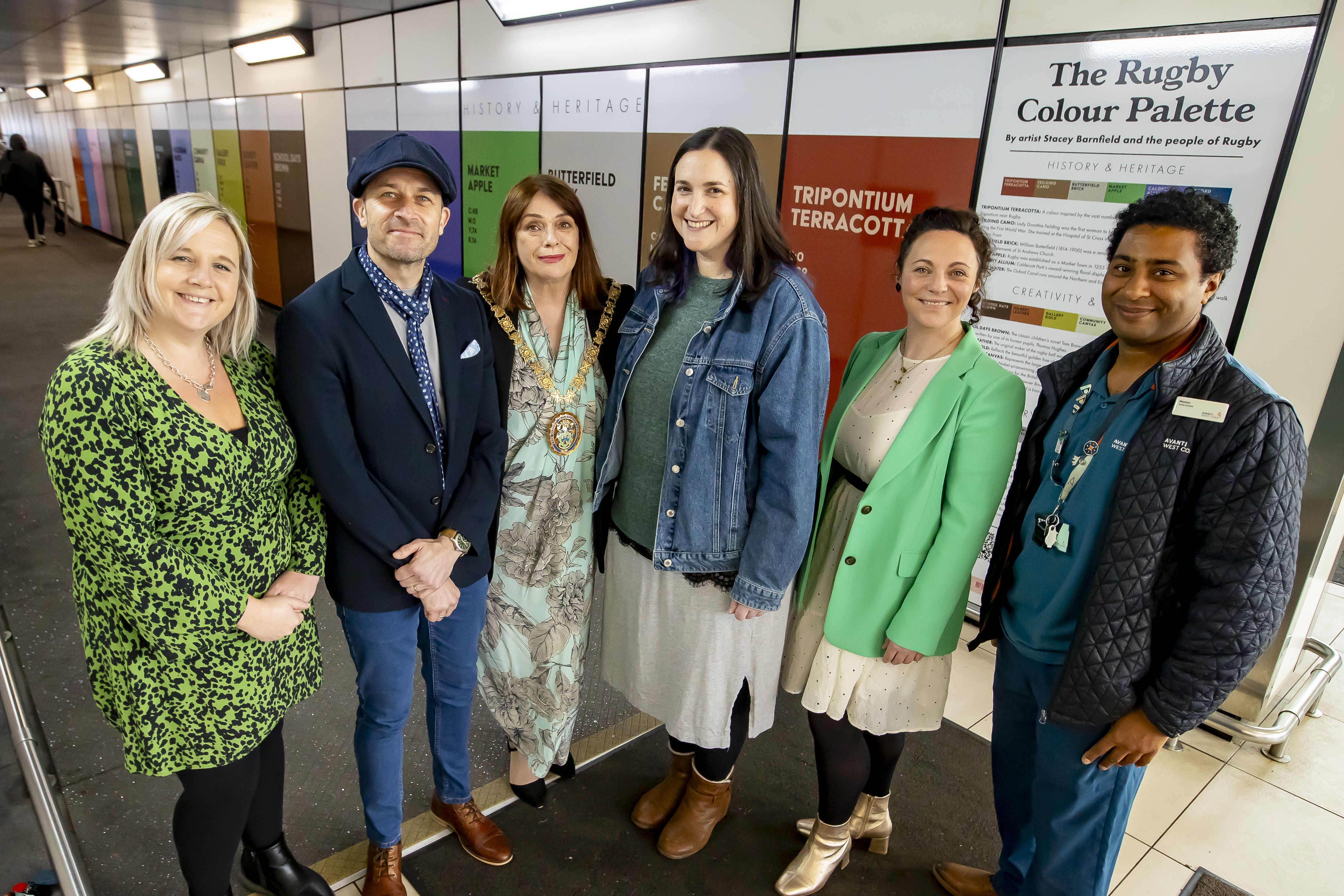
L-R: Sarah Sheldon - Station Manager, Stacey Barnfield - The Colour Palette Company, Cllr Maggie O'Rourke - Mayor of Rugby, Julia Singleton-Tasker - Lead CRP Officer, Sarah Annis - Ruby Road, Marlon Golding - Team Leader
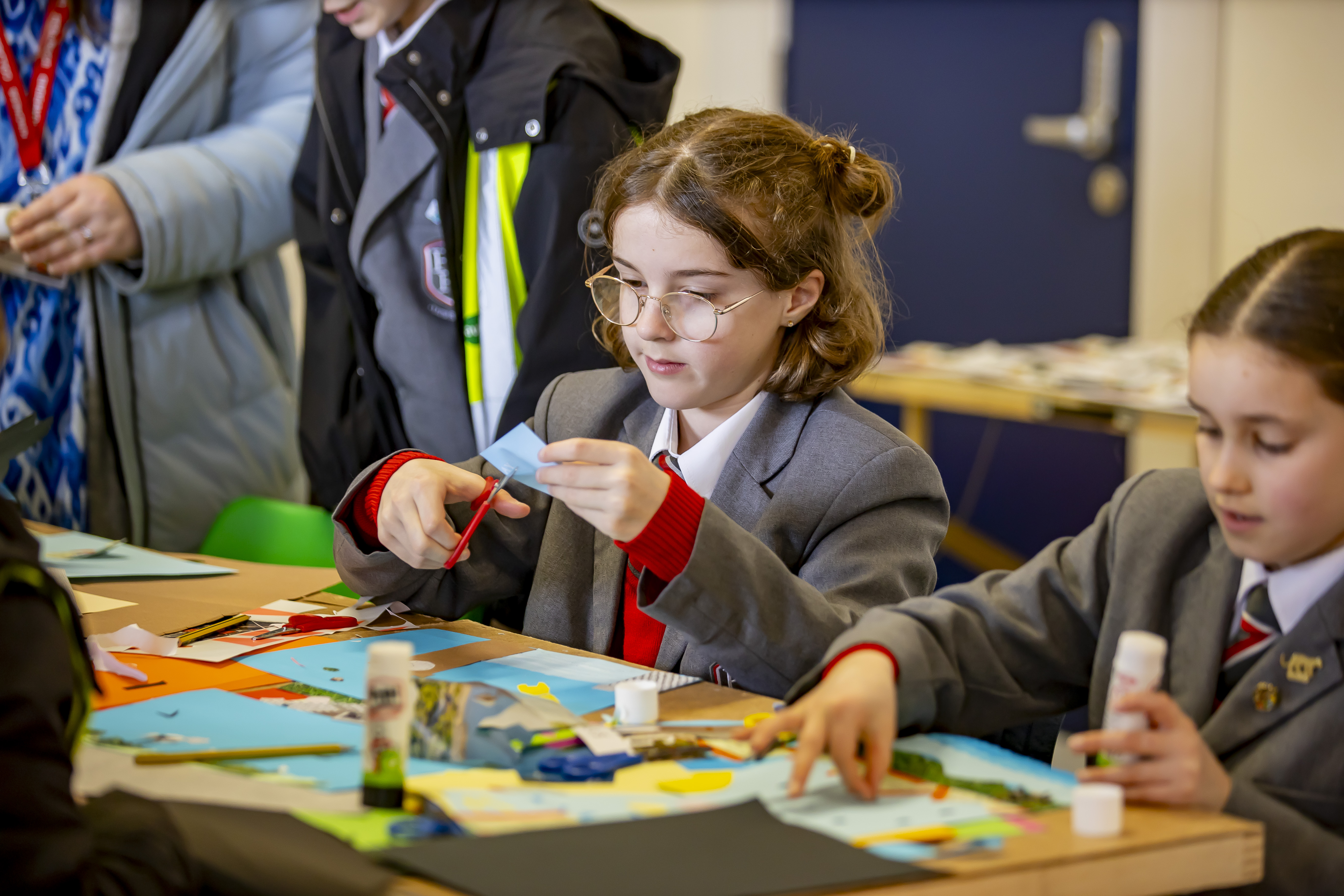
Thanks to Rugby Art Gallery and Museum, pupils from Rugby Free Primary and Riverside Academy took part in a workshop led by Clare Pentlow as part of our launch.




